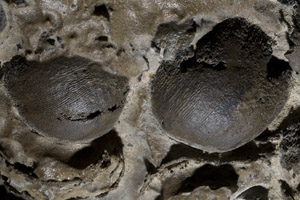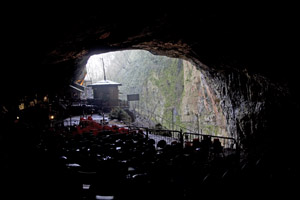Most of the northern caves are formed in Carboniferous limestone. The Carboniferous Period stretched from 360 to 280 million years ago (mya) and is split into the Lower (360 to 310 mya) and Upper Carboniferous (310 to 280 mya). The limestone was deposited during the Lower Carboniferous, a period of shallow, warm seas in which corals, brachiopods, crinoids, blastoids, bryozoans and foraminifera flourished, hence the limestone is rich in fossil deposits.
Most fossils are composed of a type of calcite but in the Peak District silicified fossils are also common often in association with chert nodules or quartz rock.
SEALIFE FOSSILS of the CARBONIFEROUS LIMESTONE
Algae At the top of the Great Scar limestone is a metre thick band of rock containing algal fossils called Girvanella, it is a very dark grey rock. Good examples are at the entrance of Birks Fell Cave and Loose Pot, Newby Moss. Givanella nodules are actually formed by a symbiotic relationship including the algae Givanella forming concentric rings around the growth.
Corals were abundant and diverse in Carboniferous seas and included both colonial and solitary forms. Corals are soft bodied animals that live in a calcareous, tubular skeleton. There are two orders of fossilised coral commonly found in the carboniferous limestone, the Rugosa and the Tabulata. They were abundant in the Devonian period but became less common through the Carboniferous before dying out in the Permian-Triassic extinction event.
Rugose corals - solitary and colonial species. Rugose corals have a wrinkled, or rugose, wall and usually have vertical septae that are visible in the cross section of the fossil.
Solitary ones are also called horn corals because they are a horn shape. They grew up to 1m in length.
Solitary examples: Caninia, Dibunophyllum (a large solitary coral), Zaphrentis.
Colonial examples: Lithotrotian minus found in the S2 (Holkerian) zone.
Some are used as geological markers such as Dibunophyllum bipartitum, D. bourtonense.
Tabulate corals are mostly colonial. Their structure resembles a honeycomb and the tubes lack vertical partitions (septae).
Examples: Syringopora
Brachiopods (lamp shells) have two unequal shells, each symmetrical about the midline and they lived attached to the seafloor by a stalk - the pedicle. Their fossils are most commonly seen in the caves in cross-section, appearing like white ellipses and semicircles. Although many species (95%) became extinct in the Permian-Triassic extinction, some relatives can still be found mainly out of sight in very deep, cold seawater. Productus and Gigantoproductus fossils are common, these larger brachiopods used to live in a lagoon environment. The small horny brachiopod Lingula can be found in dark grained limestones around the Ashford basin. Dielasma Cave near Castleton is named after a brachiopod which can be found in the adjacent rocks.
|
Gigantoproductus in the roof of Carlswark Cavern. |
|
Dielasma brachiopod, Dielasma Cave |
Bivalves (=Lamellibranch) are similar to Brachiopods but the two parts of the shell are symetrical (like clams). Brachiopods were dominant before the Permian-Triassic extinction event, but the Bivalves may have been better adapted to survive and became dominant following the event. Bivalve fossils can be found in reef limestones.
Goniatites are extinct ammonoids in the Mollusc phylum (ammonites came 200 million years later). They are shelled cephalopods related to squid and octopus. The coiled shell (like a snail) is usually under 5cm in size with a characteristic zig-zag patterns of sutures on the outside. There is a bed of goniatites at Cowlow Nick, Castleton.
Crinoids (sea lilies) consisted of a segmented stem with a crown of feathery arms on top. When the animal died it disintegrated into the individual segments (ossicles) or into short lengths of stem consisting of a few connected ossicles. Often, this debris drifted to accumulate as thick beds to form crinoidal limestones. The fossil ossicles appear in cross section as circles, ellipses and rectangles depending on the angle of the section. If a length of stem is found the joints between the ossicles can be seen.
|
Fossilised fragment of a crinoid stem, Giants Hole |
The Blastoids are an extinct form of echinoderm, distantly related to the crinoids and modern sea urchins and are especially common in Lower Carboniferous rocks. The fossils consist of a small (1 to 3cm) cup-like, plated body holding the animal itself and a short stem attaching the body to the sea bed.
Bryozoans (moss animals) are aquatic, colonial animals, whose colonies exhibit encrusting, branching or fan-like growth. Modern species still exist today in both fresh and marine waters.
The Foraminifera are microscopic Protozoa. The single-celled organism is contained in a test (shell) made from cemented foreign particles or lime. They were very abundant in ancient times and species still exist today. They are sometimes so abundant that their tiny shells cover thousands of square miles of ocean floor and form great deposits of ooze. Chalk is generally made up of fossilised Foraminifera deposits.
QUATERNARY FOSSIL MAMMALS AND ARCHAEOLOGY
The Quaternary period spans the last 2.588 million years of earth history when the climate cooled, culminating in the ice ages of the Middle to Late Quaternary with ice sheets repeatedly covering much of Britain. The first epoch of the Quaternary is the Pleistocene which ended with the ending of the last ice age around 12,000 B.P. At the end of the Pleistocene there was a major extinction event that included Neanderthal man, cave bear and woolly mammoths. The Pleistocene was followed by the Holocene epoch, an interglacial period that exists today.
Over the last 500,000 years Britain has experienced 5 full glacial cycles from warm (peak interglacial) to glacial and back to peak interglacial conditions. For most of each cycle, the climate was cool with steppe or tundra conditions, rather than the extremes of either peak interglacials (closed deciduous woodland) or full glacials (ice sheets with polar deserts to the south).
A fissure at Hazelbadge, Bradwell yielded mammoth, reindeer, woolly rhinocerus and hyaena. Cave bear, hippopotamus and bison have been found in Elder Bush Cave, lemmings at Owlet Hole and the sabre-toothed tiger at Victory Quarry, Buxton.
Human use of caves dates mainly from the Late Quaternary period, with Middle Palaeolithic (Old Stone Age) Neanderthal hunters using caves from about 60,000 years BP, to Late Palaeolithic man around 35,000 years BP, and then early modern human Homo sapiens. At that time (~60,000-10,000 yrs BP) other creatures roaming about outside included wolverine, horse, bison, reindeer, woolly rhino, and woolly mammoth: most of the bones of these species found in caves were brought in by hyenas. Evidence shows that Britain was fairly uninhabited by humans during the coldest part of the ice age (26,000-13,000 yrs BP). Wolverine and reindeer are typical tundra species.
The ice from the last ice age retreated from northern Britain around 10 000 years ago, man was probably back in the area 1000-2000 years later.
During the Neolithic period, around 4000 bc, the climate began warming up and stayed warm and dry through the Bronze Age before cooling down in the Iron Age around 800 bc. Evidence of human use of caves has been found in several caves including Elder Bush Cave, Fox Hole, Thor's Fissure.
A number of caves appear to have been used in Roman times including Thirst House, Poole's Cavern, Thor's and Ossom's Eyrie. The latest use has been the entrance to Peak Cavern where rope were made in the last century.
|





